Ted and I started our day with a visit to the Taos Pueblo and ended the day in Pueblo, CO–in other words, we went from pueblo to Pueblo. (Insert groan here.)
The Taos Pueblo is over 1,000 years old. It is a UNESCO World Heritage Site, and is an active, living community, not a reproduction of pueblo life. All of the pueblos belong to the community, but the homes in the pueblos belong to individual families. Living in the pueblo means having no modern amenities–no electricity or running water. Residents usually have a propane stove for cooking and heating.
In 1847, the Taos Pueblo revolted against the U.S. Military and won. The Taos Pueblo people have never been conquered, and have maintained their culture and tradition. Tiwa is the native Taos Pueblo language. It is an oral language and could disappear quickly, so the tribal elementary schools teach Tiwa and English. Tribal high schools require an additional foreign language, so tribal members are fluent in at least three languages. The Spanish brought Catholicism to the tribe, and the church in the pueblo is Catholic, but tribal members also practice their native religion. Yesterday, we were unable to visit the Taos Pueblo because the tribe was celebrating a native religious holiday.
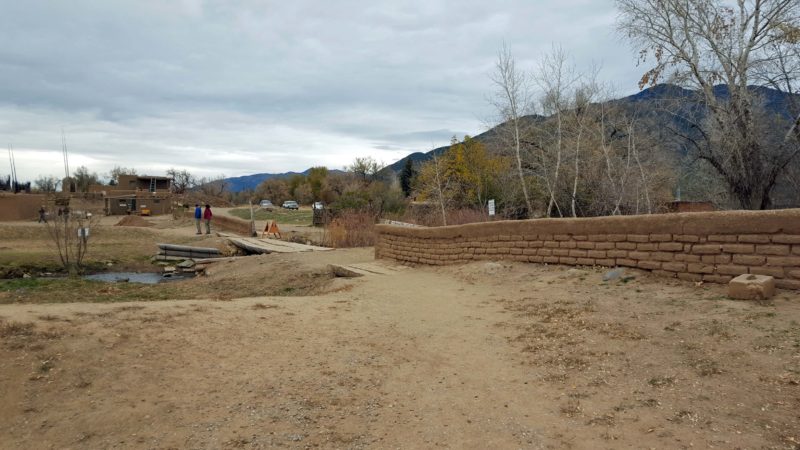
Here is a portion of the wall that surrounds the Taos Pueblo. It was originally 13 feet high for protection.

The white arch is the entry to the churchyard. This is a Catholic church. Only the far end of the building (crosses on the roof) is the church; the other part is pueblo homes. More homes are in the right background.
There are currently four resident families in the pueblo, numbering about 25 people, but there are another 1,500 tribal members living on tribal land outside the pueblo. As long as they are living outside the pueblo wall, they may have a modern lifestyle. Tribal members pay federal taxes, but they have their own tribal government. Most people use their pueblo home as a second home: they live outside the pueblo walls, but return to the pueblo for religious holidays and community events. Many of the homes are shops, selling food and handmade items to tourists.

This is the largest building in the Taos Pueblo, and has five levels. Each doorway is a separate home. The homes are small–about 12 feet square with low ceilings. Food is prepared in adobe ovens or on propane stoves. The adobe walls in all the pueblo buildings are 3-5 feet thick to keep the interior cool in the summer and to keep it warm in the winter.
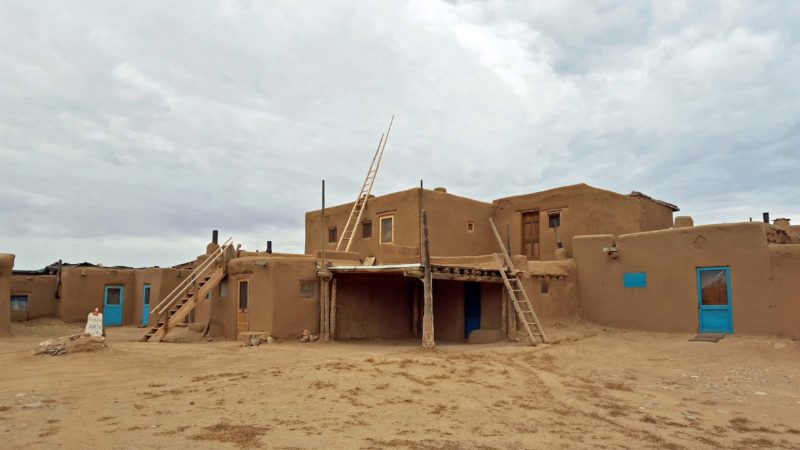
Originally, pueblo homes had no doors. Ladders were used to climb up to the roof and then to climb down into the home through a “skylight.” This provided protection from intruders. Today, the homes have doors cut into them. Many are painted blue to ward off evil spirits.

This is a view through a series of drying racks. Meats and vegetables are hung on the upper crossbars to dry and preserve for future use.
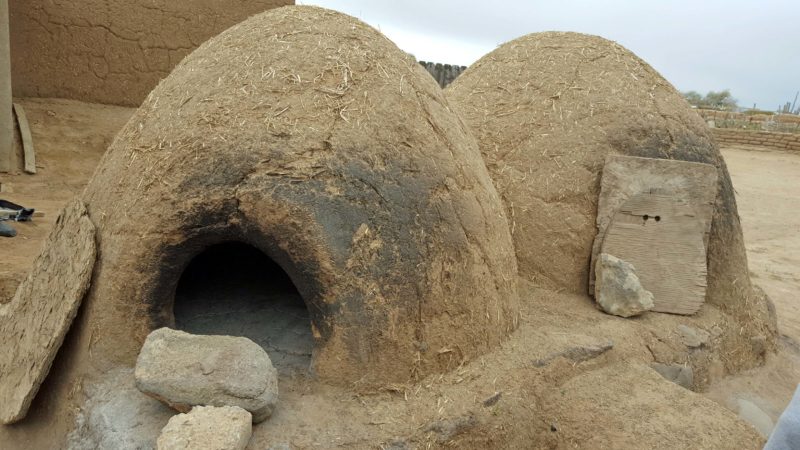
Adobe ovens are used for baking. Cedar wood is burned inside for about an hour to heat the oven. Then the wood and ashes are removed, the to-be-baked goods are put inside, and the door is covered. The inside baking temperature is 300-400 degrees, and each oven can hold 25-30 loaves of bread.

The center structure is another multi-story pueblo. Smaller pueblo homes surround it. To grasp the size of the pueblo homes, subtract 3-5 foot thick walls from the exterior measurement. The stream in the foreground comes directly from the mountain and is untreated, but it is so clean that it can be used for everything–washing, cooking, bathing, etc.

The center building with the bell tower was the original pueblo church. The U.S. Military destroyed it during an attack, believing that the pueblo residents were hiding in it. (They had actually hidden in the mountains.) The original churchyard area is now used as a cemetery. There is an oven in the center of the picture and pueblo homes on the left and right.
After our visit to the Taos Pueblo, Ted and I had lunch at a microbrewery in Taos. Local restaurants are always interesting. This one had a “painting” made of beer bottle caps.

I apologize for the blurring, but you get the idea of how creative a beer-cap artist can be.
Ted and I have been driving scenic roads whenever we can. Today, we followed New Mexico SH64. It was curvy, mountainous, and beautiful. I think our average speed was under 40 mph, but we were in no hurry and the views were worth it. Part of the highway was named the “Enchanted Circle Scenic Byway,” and quite a bit of it was the historic Santa Fe Trail as well.

Winter is getting closer, and it’s becoming a challenge to find fall colors on the trees. Picture yellow-gold leaves on these trees.
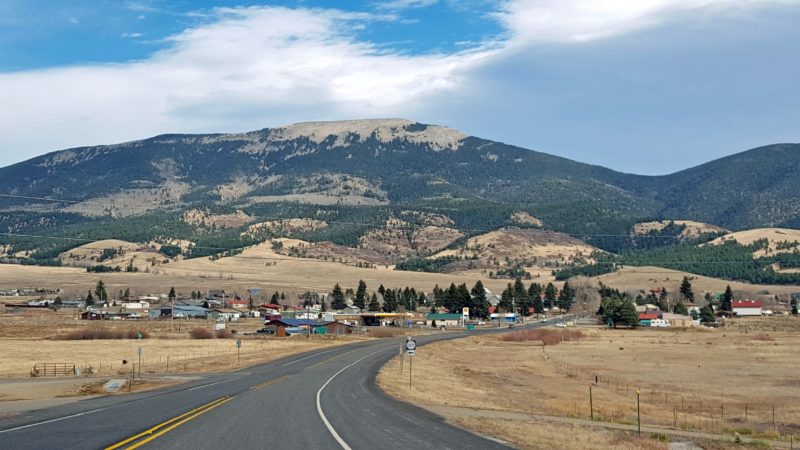
Here’s a village nestled in a valley.
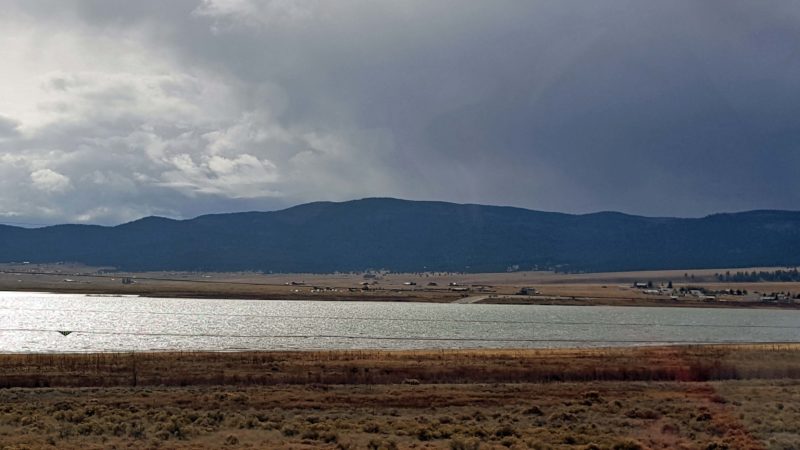
To quote Sting, “Heavy cloud, but no rain” to spoil our views on SR 64.

The Santa Fe Trail continued on I-25.
After visiting Roswell, NM and Hooper, CO–two sites where large numbers of people have reported sightings of UFOs, Ted seems to be getting into the mood. He thought he saw a UFO in the sky today.

Oh, those funny meteorologists!